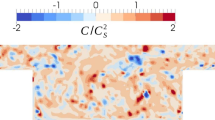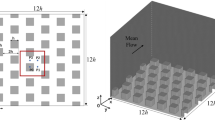Abstract
Large-eddy simulations have been performed for fully developed turbulent flow within and above explicitly resolved simple cube arrays. The results from our model, hereafter LES-CITY, are shown to agree with laboratory experiments. We investigated the systematic influence of cube density on turbulent flow characteristics by performing numerical experiments for cube areal densities from 0 to 44%. The following results were obtained: (1) The dispersive momentum flux was quite large within the canopy layer due to a mean stream re-circulation, whereas it was smaller above the canopy. The spatial variation of temporally averaged momentum in the roughness sub-layer was 20% or less of the total kinematic surface drag. (2) The temporally and spatially-averaged flow structure confirmed the existence of conventionally described canyon flow regimes; isolated, interfacial, and wake. However, the intermittency of the canyon flow for all cube densities was quite large and the stream patterns were never persistent. (3) Turbulent organized structures (TOS) similar to those observed in turbulent surface-layer flows were simulated, which are characterized by longitudinally-elongated low speed streaks and the corresponding shorter streamwise vortices. The streaks in sparse and dense canopy flows were likely to be aligned to the street line and to the roof lines, respectively. Such heterogeneity of TOS partially accounts for the large spatial variation of momentum flux. (4) In contrast to the mixing layer analogy of vegetation flows, the TOS and the resulting turbulent statistics of urban flow above the canopy resembled those in surface layers. The recirculation within the canopy significantly influenced the turbulent statistical properties.
Similar content being viewed by others
References
Briscolini, M. and Santangelo, P.: 1989, ‘Development of the Mask Method for Incompressible Unsteady Flows’, J. Comput. Phys. 84, 57–75.
Cheng, H. and Castro, I. P.: 2002, ‘Near Wall Flow over Urban-Like Roughness’, Boundary-Layer Meteorol. 104, 229–259.
Cook, N. J.: 1978, ‘Determination of the Model Scale Factor in Wind-Tunnel Simulations of the Adiabatic Atmospheric Boundary Layer’, J. Ind. Aerodyn. 2, 311–321.
Deardorff, J. W.: 1980, ‘Stratocumulus-Topped Mixed Layers Derived from a Three-Dimensional Model’, Boundary-Layer Meteorol. 18, 495–527.
Gao, W., Shaw, R. H., and Paw U, K. T.: 1989, ‘Observation of Organized Structure in Turbulent Flow within and above a Forest Canopy’, Boundary-Layer Meteorol. 47, 349–377.
Grimmond, C. S. B. and Oke, T. R.: 1999, ‘Aerodynamics Properties of Urban Areas Derived from Analysis of Surface Form’, J. Appl. Meteorol. 38, 1262–1292.
Hall, D. J., Macdonald, R. W., Walker, R., and Spanton, A. M.: 1996, ‘Measurements of Dispersion within Simulated Urban Arrays-A Small Scale Wind Tunnel Study’, BRE Client Report CR 178/96, Building Research Establishment, Garston, Watford.
Hanna, S. R., Tehranian, S., Carissimo, B., Macdonald, R. W., and Lohner, R.: 2002, ‘Comparisons of Model Simulations with Observations of Mean Flow and Turbulence within Simple Obstacle Arrays’, Atmos. Environ. 36, 5067–5079.
Hommema, S. E. and Adrian, R. J.: 2003, ‘Packet Structure of Surface Eddies in the Atmospheric Boundary Layer’, Boundary-Layer Meteorol. 106, 147–170.
Hussain, A. K. M. F. and Reynolds, W. C.: 1975, ‘Measurements in Fully Developed Turbulent Channel Flow’, Trans. ASME, J. Fluids Eng. 97, 568–580.
Iyengar, A. K. S. and Farell, C.: 2001, ‘Experimental Issues in Atmospheric Boundary Layer Simulations: Roughness Length and Integral Length Scale Determination’, J. Wind Eng. Ind. Aerodyn. 89, 1059–1080.
Jackson, P. S.: 1981, ‘On the Displacement Height in the Logarithmic Velocity Profile’, J. Fluid Mech. 111, 15–25.
Kaimal, J. C. and Finnigan, J. J.: 1994, Atmospheric Boundary Layer Flows-Their Structure and Measurements, Oxford University Press, Oxford, 289 pp.
Kanda, M. and Hino, M.: 1994, ‘Organized Structures in Developing Turbulent Flow within and above a Plant Canopy, Using a Large Eddy Simulation’, Boundary-Layer Meteorol. 68, 237–257.
Kanda, M., Inagaki, A., Marcus O. Z., Raasch, S., and Watanabe, T.: 2004, ‘LES Study of the Energy Imbalance Problem with Eddy Covariance Fluxes’, Boundary-Layer Meteorol. 110, 381–404.
Kogaki, T., Kobayashi, T., and Taniguchi, N.: 1997, ‘Large Eddy Simulation of Flow around a Rectangular Cylinder’, Fluid Dyn. Res. 20, 11–24.
Louka, P., Belcher, S. E., and Harrison, R. G.: 2000, ‘Coupling between Air Flow in Streets and the Well-Developed Boundary Layer Aloft’, Atmos. Environ. 34, 2613–2621.
Macdonald, R. W.: 2000, ‘Modeling the Mean Velocity Profile in the Urban Canopy Layer’, Boundary-Layer Meteorol. 97, 25–45.
Macdonald, R.W., Griffiths, R. F., and Hall, D. J.: 1998, ‘An Improved Method for the Estimation of Surface Roughness of Obstacle Arrays’, Atmos. Environ. 32, 1857–1864.
Macdonald, R. W., Schofield, S. C., and Slawson, P. R.: 2002, ‘Physical Modeling of Urban Roughness Using Arrays of Regular Roughness Elements’, Water, Air, Soil Pollution: Focus 2, 541–554.
Moin, P. and Kim, J.: 1985, ‘The Structure of the Vorticity Field in Turbulent Channel Flow. Part 1. Analysis of Instantaneous Fields and Statistical Correlations’, J. Fluid Mech. 155, 441–464.
Murakami, S., Mochida, A. Ooka, R., Kato, S., and Iizuka, S.: 1996, ‘Numerical Prediction of Flow around a Building with Various Turbulence Models: Comparison of k-e EVM, ASM, DSM and LES with Wind Tunnel Tests’, ASHRAE Trans., AT-96-10-1.
Oikawa, S. and Meng, Y.: 1995, ‘Turbulence Characteristics and Organized Motion in a Suburban Roughness Sublayer’, Boundary-Layer Meteorol. 74, 289–312.
Oke, T. R.: 1988, ‘Street Design and Urban Canopy Layer Climate’, Energ. Buildings 11, 103–113.
Raasch, S. and SchrÖter, M.: 2001, ‘PALM-A Large-Eddy Simulation Model Performing on Massively Parallel Computers’, Meteorol. Z. 10, 363–372.
Raupach, M. R., Coppin, P. A., and Legg, B. J.: 1986, ‘Experiments on Scalar Dispersion within a Model Plant Canopy Part 1: The Turbulence Structure’, Boundary-Layer Meteorol. 35, 21–52.
Raupach, M. R., Finnigan, J. J., and Brunet, Y.: 1996, ‘Coherent Eddies and Turbulence in Vegetation Canopies: The Mixing-Layer Analogy’, Boundary-Layer Meteorol. 78, 351–382.
Raupach, M. R., Thom, A. S., and Edwards, I.: 1980, ‘A Wind-Tunnel Study of Turbulent Flow Close to Regularly Arrayed Rough Surfaces’, Boundary-Layer Meteorol. 18, 373–397.
Roth, M.: 2000, ‘Review of Atmospheric Turbulence over Cities’, Quart. J. Roy. Meteorol. Soc. 126, 941–990.
Sada, K. and Sato, A.: 2002, ‘Numerical Calculation of Flow and Stack-Gas Concentration Fluctuation around a Cubical Building’, Atmos. Environ. 36, 5527–5534.
Schoppa, W. and Hussain, F.: 2002, ‘Coherent Structure Generation in Near-Wall Turbulence’, J Fluid Mech. 453, 57–108.
Theodorsen, T.: 1952, ‘Mechanism of Turbulence’, in Proceeding of the Second Midwestern Conference of Fluid Mechanics, Ohio State University.
Thom, A. S.: 1972, ‘Momentum, Mass and Heat Exchange of Vegetation’, Quart. J. Roy. Meteorol. Soc. 98, 124–134.
Uehara, K., Murakami, S., Oikawa, S., and Wakamatsu, S.: 2000, ‘Wind Tunnel Experiments on How Thermal Stratification Affects Flow in and above Urban Street Canyons’, Atmos. Environ. 34, 1553–1562.
Uehara, K., Wakamatsu, S., and Ooka, R.: 2003, ‘Studies on Critical Reynolds Number Indices for Wind-Tunnel Experiments on Flow within Urban Areas’, Boundary-Layer Meteorol. 107, 353–370.
Uno, I., Ueda, H., and Wakamatsu, S.: 1989, ‘Numerical Modeling of the Nocturnal Urban Boundary Layer’, Boundary-Layer Meteorol. 49, 77–98.
Zhou, J., Adrian, R. J., Balachandar, S., and Kendall, T.: 1999, ‘Mechanisms for Generating Coherent Packets of Hairpine Vortices in Channel Flow’, J. Fluid. Mech. 387, 353–396.
Author information
Authors and Affiliations
Rights and permissions
About this article
Cite this article
Kanda, M., Moriwaki, R. & Kasamatsu, F. Large-Eddy Simulation of Turbulent Organized Structures within and above Explicitly Resolved Cube Arrays. Boundary-Layer Meteorology 112, 343–368 (2004). https://doi.org/10.1023/B:BOUN.0000027909.40439.7c
Issue Date:
DOI: https://doi.org/10.1023/B:BOUN.0000027909.40439.7c




